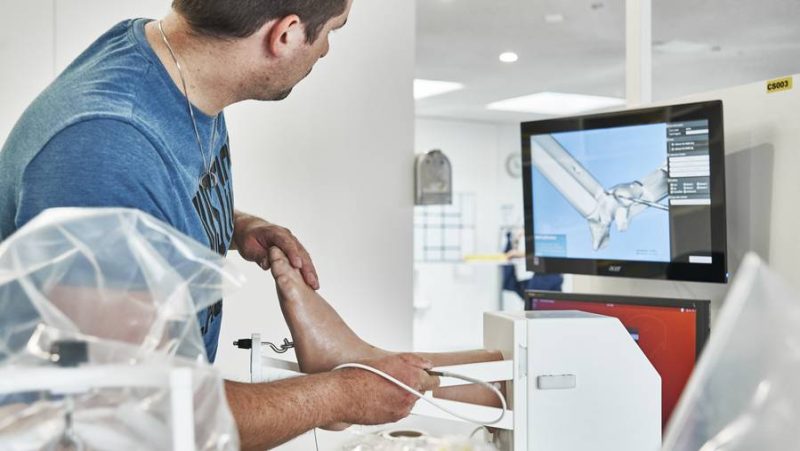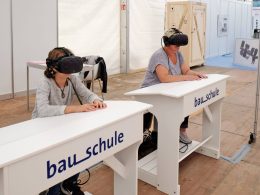Thanks to virtual reality simulators from Virtamed, budding doctors can practise simple procedures. The Schlierem-based company has now received an award from the Swiss government for its export strategy.
What cruciate ligament surgery looks like from the inside of a knee can be seen in Schlieren at Virtamed up close with VR: A surgical instrument, a so-called shaver, appears on the lower edge of the screen and moves towards a cartilaginous structure, slowly removing it. The shaver moves away from the cartilage towards the bone. It drills into it, creating a reddish pit. Blood clots float around the surgical instruments.
Export Award cleared up
In the perfectly lit showroom on Rütistrasse - just a few minutes from the train station - the knee is to show customers, visitors and interested parties exactly what the company does. The virtual reality surgery simulators, which make it possible to practise medical procedures, are a success. Only recently Virtamed received the Export Award from Switzerland Global Enterprise (S-GE). On behalf of the State Secretariat for Economic Affairs (Seco), S-GE promotes exports and investment in Switzerland as a business location.
The fact that trainee or already trained doctors can practise routine operations using the virtual reality simulators is a quantum leap in medical history. "In the past, operations were practised on living patients or cadavers. However, due to high potential for error and for reasons of piety, this is no longer appropriate," says the medtech company's marketing manager Phil Norris. In addition to teaching hospitals and training centres, medical technology manufacturers are also among the company's customers.
The haptic is important
The plastic model is anatomically correct. "It is important that a surgeon also has a haptic experience. When he hits bone, he has to feel it, not just see it," says Norris. On the screen, it is possible to follow where the star has been moved. "The number of clinical pictures we can offer with our software is constantly being expanded. There are currently 19, compared to 14 a year ago," says Norris.The company's portfolio includes much more than the knee, however. In addition to hip and ankle joints, Virtamed has also developed shoulder joints on which a variety of operations can be practised. The gynaecological surgery simulator is one of the latest products.
Norris uses the model to show how a coil is inserted. For this procedure, an internal view on the computer screen is omitted, as this would also be missing in a regular procedure. After the IUD has been placed, Norris receives a detailed evaluation of his performance. Besides the fact that the programme controlled all steps - strictly according to the textbook - it also measured time and precision.
A few months ago, Virtamed launched its latest coup: the simulator for gynaecological procedures on pregnant women. Aspiring doctors can now use it to practise taking ultrasound images or transferring embryos during artificial insemination.
ETH spin-off in growth
Virtamed was founded in 2007 by six doctoral students as a spin-off from ETH. Today's CEOs Stefan Tuchschmid and Raimundo Sierra were two of them. The company's first office was in the Technopark in Kreis 5 in the city of Zurich, but because space became too limited there, it moved to Rütistrasse in Schlierem in 2012. We have already reported on the company at the VR Forum 2017. reports.
With the different characteristics of the products in terms of hardware and software, the prices also vary. The model of the female abdomen costs around 50,000 francs. More complex devices, such as those for interventions on joints, can cost up to 100,000 Swiss francs.
Today, the company employs around 110 people, 100 of whom work on Rütistrasse, the rest are spread around the world. Although employees from around 20 nations work for the company, regional networking is also important.
Source: limmattalerzeitung









